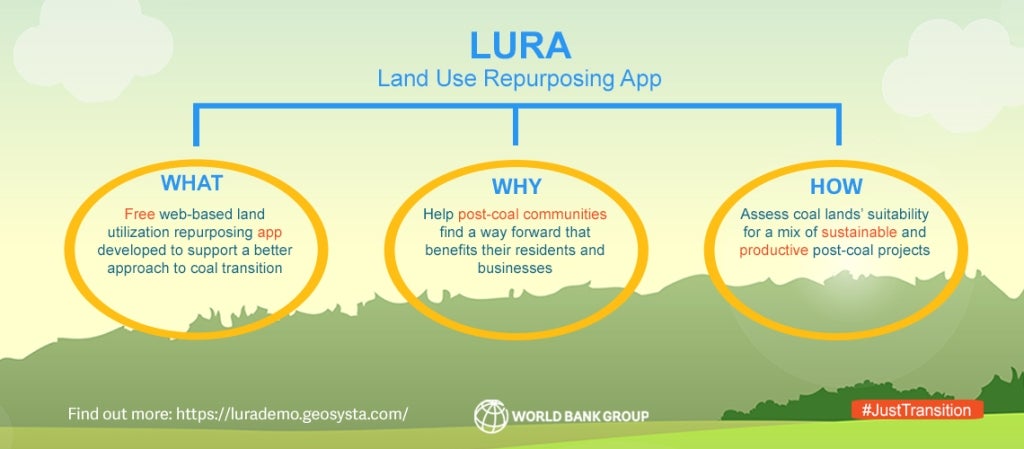 The author, Wolf Pohl, visiting a mine gathering information to put in the LURA app. World Bank
The author, Wolf Pohl, visiting a mine gathering information to put in the LURA app. World Bank
Land is scarce in many parts of our fast-urbanizing world. Few communities have the chance to create something brand-new on a significant piece of land—and even fewer can develop that land in a way that confronts climate change, generates jobs, and attracts investment.
But that opportunity is now presenting itself in Bosnia, Greece, Poland, Serbia and soon in the very large coal-producing and consuming economies in South and East Asia. In those regions, the transition away from coal offers the prospect of repurposing post-mining land—fueling both economic opportunities and clean energy. Research shows that post-mining lands play a key role in the shift to renewables: “There is enough space in post-mining lands to generate as much electricity with solar as all the coal and lignite power currently produced in the EU,” as one report concluded.
To help post-coal communities navigate a path to jobs and investment while also mitigating climate change, a World Bank team built LURA—the Land Use Repurposing Application. LURA is a free, web-based, open-source tool that assesses coal lands’ suitability for a mix of sustainable and productive post-coal projects. It has already been used successfully in the three years since its introduction. In Greece, for example, the government is moving forward with most of LURA’s recommendations for repurposing the Kozani Lignite area. Solar PV installation on a massive scale will begin soon, and a plan that includes new business and industrial areas is also in the works.
A transformative tech tool
LURA relies on collaborative input from mine operators and workers, technical specialists, municipal authorities, and the community as a whole to examine a site based on five criteria: location; geotechnical risks and legacies; topographical and hydrological conditions; environmental conditions and risks; and development opportunities.
Since coal mines are often the primary economic driver in their region, the question of jobs is an equally important input. The details of a potential labor transition for miners, as well as for workers in indirect jobs and related sectors, also drives LURA’s analysis.
Once stakeholders’ input has been added, LURA produces a map of the area, depicting zones where specific repurposing options would be most likely to succeed, given the conditions and the community’s needs. The app then assigns a post-mining repurposing scenario that may include forests, agriculture, natural habitats or energy crops, as well as renewable energy generation and storage, hydrogen-infrastructure, and business parks for low-carbon industries.

Nothing like LURA has ever existed before, and it fulfills a critical need—for the climate as well as the local community. In the two decades I’ve worked in the field of mine closure, I’ve seen this need first-hand. Until recently, many mines were closed with a minimum of effort, with bare-bones environmental and safety measures and little thought to economic revitalization or the well-being of nearby residents. As a result, numerous post-coal communities have been deprived of economic benefits to which they could have laid claim.
Building the “Just Transition” toolbox
The repurposing of former mining lands and assets is part of the World Bank’s approach to the Just Transition, a process that puts people and communities at the center of the transition to clean energy. The World Bank uses a wide variety of diagnostic and advisory tools to support governments preparing to transition away from coal; other steps include creating effective governance structures for coordinating across ministries, addressing regulatory impediments, and designing effective policies to help re-train workers, as explained here.
Since many coal-producing countries lack the resources needed to remediate impacted lands and capitalize on the economic opportunities a transition away from coal makes possible, LURA is key to supporting Just Transition efforts. So far, the results have been eye-opening for many in-country stakeholders who use the app, because post-mining lands are often seen as a liability. Instead, LURA shows with great specificity how the land can generate economic benefits—for example, by hosting industrial parks that help diversify the region’s business potential. Once mayors and municipalities can make the argument that land has value, they can use it as collateral to raise investment.
During the three years since LURA was introduced, one result in particular has surprised us: How the app builds consensus. While repurposing land associated with the Amyntaio Mine in Greece, for example, we saw that giving communities, municipalities, workers, and other stakeholders the opportunity to participate in and benefit from a post-coal economy creates a sense of shared ownership in the outcome.
Stakeholders’ engagement is significant because repurposing land takes time, investment, and labor. It requires a stable, durable commitment among many players working in partnership, and this is important because the process of repurposing former coal land can be freighted with emotion. LURA takes the emotion out of it, creating a space for fact-based conversations about a region’s future.

Once LURA maps and proposes new uses for a coal site, there’s still miles to go—because converting coal-based land is a long-term process that varies in every region of the world. What works in Greece or Bosnia or Poland won’t necessarily work in India; plans that suit one state in India may not apply in a neighboring state. Every single transition from coal is different.
But one thing is true in every case: By offering communities a tool that analyzes facts on the ground, values collaborative input, and offers a path toward a cleaner energy, LURA can help regions transition from coal dependence to a post-coal future.
Subscribe here to stay up to date with the latest Energy blogs.


Join the Conversation